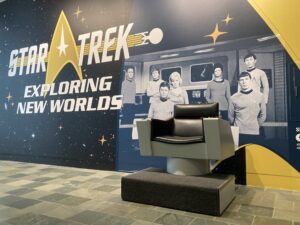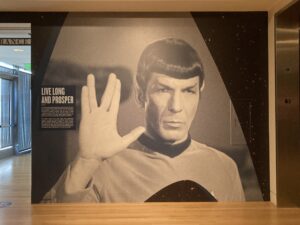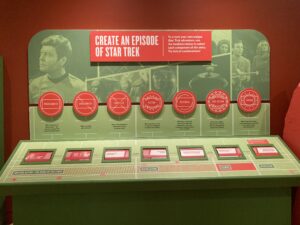‘Star Trek’ exhibition docks at the Skirball Center

(Featured image: Installation view of “Star Trek: Exploring New Worlds” at the Skirball Cultural Center. Photo by Robert Wedemeyer)
Whether you’re new to the Starship Enterprise or a hardcore Trekkie, Skirball Cultural Center’s newest “Star Trek”-themed exhibition enables all visitors to witness the impact of one of Hollywood’s biggest franchises.
Organized by the Seattle-based Museum of Pop Culture (MoPOP), under license by ViacomCBS, “Star Trek: Exploring New Worlds” opens at the Skirball on Oct. 7 and showcases “Star Trek’s” enduring influence on popular culture and technology, and how the various long-running science fiction TV series and subsequent film franchise broke boundaries. The exhibition also includes artwork, original costumes, set pieces and interactive activities designed to bring you into the “Star Trek” universe.
Running through February 2022, the exhibition also will feature a plethora of events, including a screening of “Star Trek II: The Wrath of Khan” (1982) and a concert from a “Star Trek” alt-rock tribute band.

Photo by Erin Ben-Moche
The legendary original series, created by Gene Roddenberry in the mid-1960s, follows the crew of the USS Enterprise in the 23rd century as it travels through space to make contact with new life-forms and civilizations. Jewish actors William Shatner (Capt. James T. Kirk) and Leonard Nimoy (First Officer Spock), quickly became household names. The unprecedented success of the show spawned spinoff TV series and movies. This exhibition highlights, among other things, U.S. lawmakers citing “Star Trek” in policy arguments and judges quoting the show in legal rulings. Even the Bible, works of Charles Dickens and William Shakespeare have been translated into Klingon — a language invented for the film franchise.
“For 55 years, ‘Star Trek’ has portrayed a future in which diverse crews of humans and interplanetary species work together toward a common goal, strengthened by their members’ different cultures, abilities and perspectives,” said Skirball’s Museum Director Sheri Bernstein. “There is a close connection between this optimistic, inclusive vision and our Skirball mission, which is guided by Jewish traditions of welcoming the stranger, fostering community, promoting justice and celebrating hope and discovery. ‘Star Trek’s’ vision resonates deeply with the Skirball’s commitment to using the power of the arts and storytelling to help build a society in which everyone belongs.”

Leonard Nimoy as Mr. Spock signaling the famous Vulcan salute “live long and prosper.” Nimoy took this ‘V’ motion from the Jewish Shechinah blessing. Photo by Erin Ben-Moche
Much like the crew of the Enterprise, the museum also found itself in unchartered territory with the “Exploring New Worlds” exhibition slated to open in 2020, but then the pandemic hit. So when Skirball President and CEO Jessie Kornberg arrived back on campus in July this year to prepare “Star Trek” as its headliner exhibition, she said, “Hearing the words ‘live long and prosper’ sounded really good. ‘Star Trek’s’ universe feels hopeful because the characters live these values, and we are thrilled to have the opportunity to celebrate our shared ideals.”
Walking through the exhibition, attendees will learn how “Star Trek” first came to be (thanks to Lucille Ball’s production company Desilu, which produced the original “Star Trek” series), and reenact some of its iconic moments, including a “Beam me up,” experience.
Trekkies might recognize some of the set pieces from the original series, including Captain Kirk’s command chair and the navigation console. There are more than 100 artifacts and props including an original series tricorder, communicator and phaser; Spock’s tunic worn by Leonard Nimoy; Lt. Uhura’s uniform worn by Nichelle Nichols; Khan garments, including the open-chest tunic worn by Ricardo Montalbán; and the costume worn by Benedict Cumberbatch in 2013’s “Star Trek Into Darkness,” part of the film franchise’s reboot. There also are models of the USS Enterprise and USS Excelsior.
“‘Star Trek’s’ vision resonates deeply with the Skirball’s commitment to using the power of the arts and storytelling to help build a society in which everyone belongs.” — Sheri Bernstein
Some of the original series’ more progressive choices, such as casting women and people of color in roles of power, and conveying story lines that call out injustice, may seem common to today’s audiences. However, Brooks Peck, senior curator at MoPOP, said it’s difficult today to recall how radical “Star Trek” was when it premiered in 1966. “America was in the grip of the Cold War, and many people expected that they could be annihilated at any moment,” he said. “And while we had made some progress with the Civil Rights Act of 1964 and the Voting Rights Act of 1965, racial tension was still very high. With ‘Star Trek,’ Gene Roddenberry showed a future where all those differences were set aside; where humanity was working together to explore and expand our knowledge. Today, as then, our country is divided and contentious. We need ‘Star Trek’s’ vision more than ever.”

“Create an Episode of Star Trek” is one of the many activities throughout the museum. Photo by Erin Ben-Moche
Throughout the decades, when certain topics were too taboo to discuss in public, “Star Trek” found a way to bring them to the fore. The exhibition makes a point of showcasing some of them, including a kiosk displaying clips from “Star Trek: Enterprise” when the crew faced the alien Xindi, who had launched a cataclysmic attack against Earth. Written in 2003, at the time, the Xindi storyline was a metaphor for the 9/11 attacks, and episodes from the second and third season in that arc explore themes of freedom versus security and the ends justifying the means.
Because “Star Trek” is set during a time when Earth’s problems have ostensibly been solved, the Enterprise crew instead grapples with existential questions such as, “Must we fight to the death?” “Should robots have the same rights as people?” “Could you love someone who changes bodies?” These also are questions attendees can ponder throughout the exhibition. Mirroring the show, the exhibition posits that there are no black-and-white answers.
“Starting in the days of its groundbreaking, inclusive original cast (spanning multiple nationalities, ethnicities and religions) and continuing through the present series, ‘Star Trek’ has continued to pave the way for underrepresented groups from women to BIPOC (Black, Indigenous, People of Color) to LGBTQ folks, to people with disabilities to be portrayed as leaders in space and on Earth,” said the exhibition’s Managing Curator Laura Mart. “The crews of the Starship Enterprise and other Starfleet vessels

Photo by Robert Wedemeyer.
often face great challenges and suffer losses, but with their bravery, intelligence and teamwork, they make it through with innovative solutions and new lessons for the future. That spirit,” she said, “feels appropriate for the time we are in now.”
“Star Trek: Exploring New Worlds” opens on Oct. 7 at the Skirball and runs through Feb. 20, 2022. For ticket information, click here. Proof of vaccination or negative COVID test required upon entry. For the most current information on ticketing guidelines and safety protocols, visit its website.